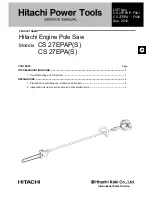
17
1.
Press cutting (cutting small workpieces) (Fig. 33)
Workpieces up to 50 mm high and 97 mm wide can be
cut in the following way.
Push the carriage toward the guide fence fully and
tighten two clamp screws which secure the slide poles
clockwise to secure the carriage. Secure the workpiece
with the vise. Switch on the tool without the blade making
any contact and wait until the blade attains full speed
before lowering. Then gently lower the handle to the fully
lowered position to cut the workpiece. When the cut is
completed, switch off the tool and WAIT UNTIL THE
BLADE HAS COME TO A COMPLETE STOP before
returning the blade to its fully elevated position.
CAUTION:
• Firmly tighten two clamping screws which secure the
slide poles clockwise so that the carriage will not move
during operation. Insufficient tightening may cause
unexpected kickback of the blade. Possible serious
PERSONAL INJURY may result.
2.
Slide (push) cutting (cutting wide workpieces)
(Fig. 34)
Loosen two clamp screws which secure the slide poles
counterclockwise so that the carriage can slide freely.
Secure the workpiece with the vise. Pull the carriage
toward you fully. Switch on the tool without the blade
making any contact and wait until the blade attains full
speed. Press down the handle and PUSH THE CAR-
RIAGE TOWARD THE GUIDE FENCE AND THROUGH
THE WORKPIECE. When the cut is completed, switch
off the tool and WAIT UNTIL THE BLADE HAS COME
TO A COMPLETE STOP before returning the blade to its
fully elevated position.
CAUTION:
• Whenever performing the slide cut, FIRST PULL THE
CARRIAGE TOWARD YOU FULLY and press down the
handle to the fully lowered position, then PUSH THE
CARRIAGE TOWARD THE GUIDE FENCE. NEVER
START THE CUT WITH THE CARRIAGE NOT FULLY
PULLED TOWARD YOU. If you perform the slide cut
without pulling the carriage fully or if you perform the
slide cut toward your direction, the blade may kickback
unexpectedly with the potential to cause serious PER-
SONAL INJURY.
• Never perform the slide cut with the handle locked in
the lowered position by pressing the stopper pin.
• Never loosen the clamp screw which secures the car-
riage while the blade is rotating. This may cause seri-
ous injury.
3.
Miter cutting
Refer to the previously covered “Adjusting the miter
angle”.
4.
Bevel cut (Fig. 35)
Loosen the lever and tilt the saw blade to set the bevel
angle (Refer to the previously covered “Adjusting the
bevel angle”). Be sure to retighten the lever firmly to
secure the selected bevel angle safely. Secure the work-
piece with a vise. Make sure the carriage is pulled all the
way back toward the operator. Switch on the tool without
the blade making any contact and wait until the blade
attains full speed. Then gently lower the handle to the
fully lowered position while applying pressure in parallel
with the blade and PUSH THE CARRIAGE TOWARD
THE GUIDE FENCE TO CUT THE WORKPIECE. When
the cut is completed, switch off the tool and WAIT UNTIL
THE BLADE HAS COME TO A COMPLETE STOP
before returning the blade to its fully elevated position.
CAUTION:
• Always be sure that the blade will move down to bevel
direction during a bevel cut. Keep hands out of path of
saw blade.
• During a bevel cut, it may create a condition whereby
the piece cut off will come to rest against the side of the
blade. If the blade is raised while the blade is still rotat-
ing, this piece may be caught by the blade, causing
fragments to be scattered which is dangerous. The
blade should be raised ONLY after the blade has come
to a complete stop.
• When pressing the handle down, apply pressure paral-
lel to the blade. If the pressure is not parallel to the
blade during a cut, the angle of the blade might be
shifted and the precision of the cut will be impaired.
5.
Compound cutting
Compound cutting is the process in which a bevel angle
is made at the same time in which a miter angle is being
cut on a workpiece. Compound cutting can be performed
at angle shown in the table.
When performing compound cutting, refer to “Press cut-
ting”, “Slide cutting”, “Miter cutting” and “Bevel cut” expla-
nations.
6.
Cutting aluminum extrusion (Fig. 36)
When securing aluminum extrusions, use spacer blocks
or pieces of scrap as shown in the figure to prevent defor-
mation of the aluminum. Use a cutting lubricant when
cutting the aluminum extrusion to prevent buildup of the
aluminum material on the blade.
CAUTION:
• Never attempt to cut thick or round aluminum extru-
sions. Thick aluminum extrusions may come loose dur-
ing operation and round aluminum extrusions cannot
be secured firmly with this tool.
Miter angle
Bevel angle
Left and Right 45°
Left 0° – 45°
Right 50°
Left 0° – 40°
Right 55°
Left 0° – 30°
Right 57°
Left 0° – 25°
Summary of Contents for LS0714F
Page 2: ...2 1 2 3 4 5 6 7 8 11 3 12 7 8 6 9 10 5 6 4 4 85 3 2 1 ...
Page 3: ...3 9 10 11 12 13 14 15 16 14 12 13 27 26 28 21 21 25 23 19 24 22 21 17 19 11 18 20 16 15 ...
Page 4: ...4 17 18 19 20 21 22 23 24 38 39 40 35 41 34 37 35 36 1 32 33 A B 15 31 29 30 ...
Page 7: ...7 38 39 40 41 42 43 44 45 21 69 70 24 22 25 18 19 68 12 36 1 67 66 51 25 ...
Page 8: ...8 46 47 48 49 50 51 75 76 77 78 75 79 52 74 52 72 73 23 25 19 71 68 7 13 ...
















































